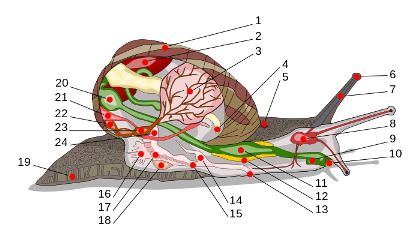
Adaptation
During development, gastropods undergo 180 degree twisting of
their body that’s inside their shell, this is called torsion
(Gillis, 2012). It is thought that
torsion first came about as an adaptation for the planktonic
larval stage, quite the beneficial mutation
(Purchon, 1968). The coiling of the
shell as it grows keeps it from growing too long and hampering
the movement of the snail when (Gillis,
2012). As Cleveland P. Hickman, Jr. explains in his sixth
edition of Animal Diversity, a result of torsion is that the
anus is positioned right above the mouth of the snail. There are
obvious draw backs to this kind of body plan, such as fouling
which is when feces are deposited
 onto the head/gills of the
(aquatic) snail. However, snails have methods to overcome such
hindrances! The clever little snails extend their heads while
eating and do not defecate when they are dining on their gourmet
snail food (see Nutrition for more
information on snail cuisine). They often move while defecating
so that the water carries the excrement away from the snail. One
may wonder why they bother with such a body plan, the answer is
simple: protection. Torsion allows the snail to have but one
exposed site in the shell, which reduces vulnerability. The only
point of exposure is where the head is and so the snail can
monitor the point of weakness, thus reducing the chances of
sneak attacks from behind
(Hickman,
2011).
onto the head/gills of the
(aquatic) snail. However, snails have methods to overcome such
hindrances! The clever little snails extend their heads while
eating and do not defecate when they are dining on their gourmet
snail food (see Nutrition for more
information on snail cuisine). They often move while defecating
so that the water carries the excrement away from the snail. One
may wonder why they bother with such a body plan, the answer is
simple: protection. Torsion allows the snail to have but one
exposed site in the shell, which reduces vulnerability. The only
point of exposure is where the head is and so the snail can
monitor the point of weakness, thus reducing the chances of
sneak attacks from behind
(Hickman,
2011).
Snails have other adaptations, specifically terrestrial snails,
which allow them to live on land. As Hickman covers in
Animal Diversity, to meet their respiration
requirements, they have lost their gills and developed a lung from
the mantle wall. An opening in the shell called a pneumostome is
where wastes are expelled via the air from the lungs in a forceful
burst, which also prevents fouling
(Hickman, 2011).
Move on to Reproduction for more interesting information!